Hens and chicks are grown both in gardens and pots. They look great in containers and can be grown in all types of containers. These succulents produce many young offsets and can fill up the pots.
So, in this article, we shall learn how to plant hens and chicks in a pot?
To plant hens and chick in a pot, Take a pot, fill it up with well-drained potting mix and plant your Hens and Chicks right at the center. Then cover the soil with mulch and move the plant to a brightly lit spot. You can water the plant and let them adjust to the new pot and environment.
If you wish to plant Hens and Chicks in pots, this article will help you understand the right way of growing Hens and Chicks in a pot. Along with that, we will also share information about caring for Hens and Chicks in pots.
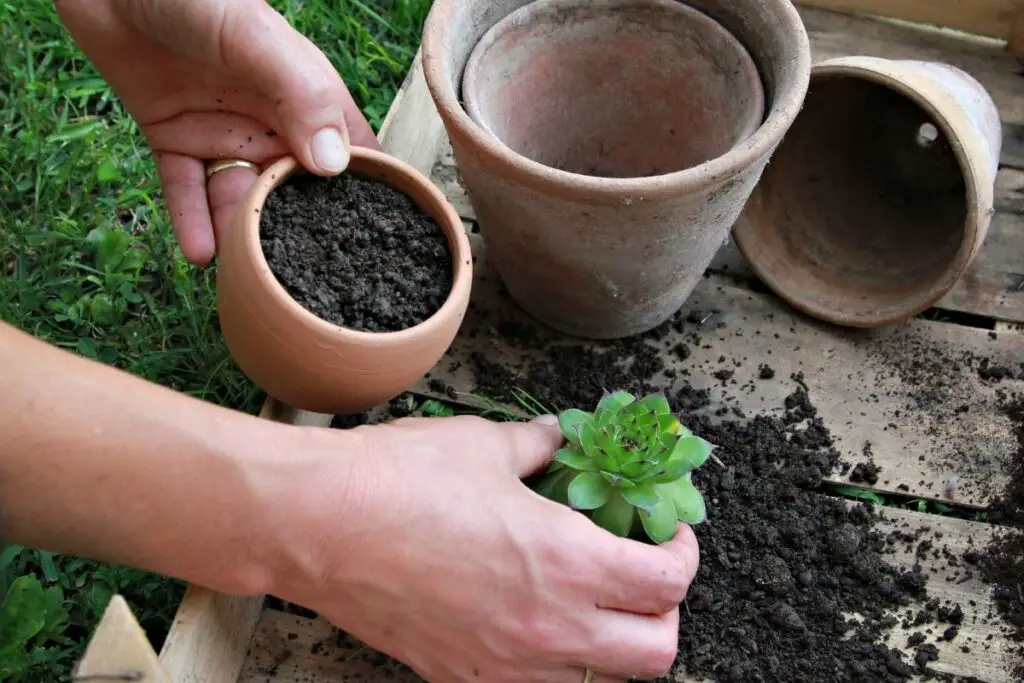
Things to keep in mind while planting Hens and Chicks in pots
Before you learn about growing Hens and Chicks in containers, remember the following aspects in this respect.
Type of pot
Reflect on three things while selecting an ideal pot-drainage holes, material, and size.
The pot for Hens and Chicks should have drainage holes to empty extra water.
The excess water won’t flow out and stay stagnant without drainage holes.
As a result, the plant will experience root rot.
Hens and Chicks can tolerate droughts but not damp conditions.
If you always overwater them by mistake, use a pot made of clay, for example, terracotta pots.
They are made of porous materials and can wick away moisture quickly. It will save your plant from overwatering.
Don’t use a too big or deep pot.
A size of 4-6 inches in depth and diameter is enough.
A shallow pot will be great because the roots of Hens and Chicks are pretty shallow.
A big pot can increase the chances of overwatering because the soil will take forever to dry.
Location
After you have finished planting Hens and Chicks in a pot, it is time for their ideal location.
You can keep them indoors or outdoors. You can place the pot in the ground or over a deck, patio, or porch.
Select south or west-facing window for the northern hemispheres for placing them indoors.
For southern hemispheres, choose west or north-facing window.
These directions will receive the maximum amount of sunlight. It is the same for the outdoor placement.
If the sun is too harsh, try the eastern direction.
It gives perfect morning sun with low intensity.
Whatever location you select, indoors or outdoors, they must receive enough sunlight for at least 6 to 8 hours per day.
Temperature and humidity are also necessary for the indoor location.
The room you have selected should not be too warm or humid. Otherwise, it can rot these succulents.
Check the temperature of the location instead.
An average temperature of about 65°F-75°F and 30%-50% humidity is necessary for vigorous growth.
Although, Hens and Chicks won’t mind cold temperatures.
Also read: Where Do Hens And Chicks Grow Best? (Best Spot+What To Look For)
Soil
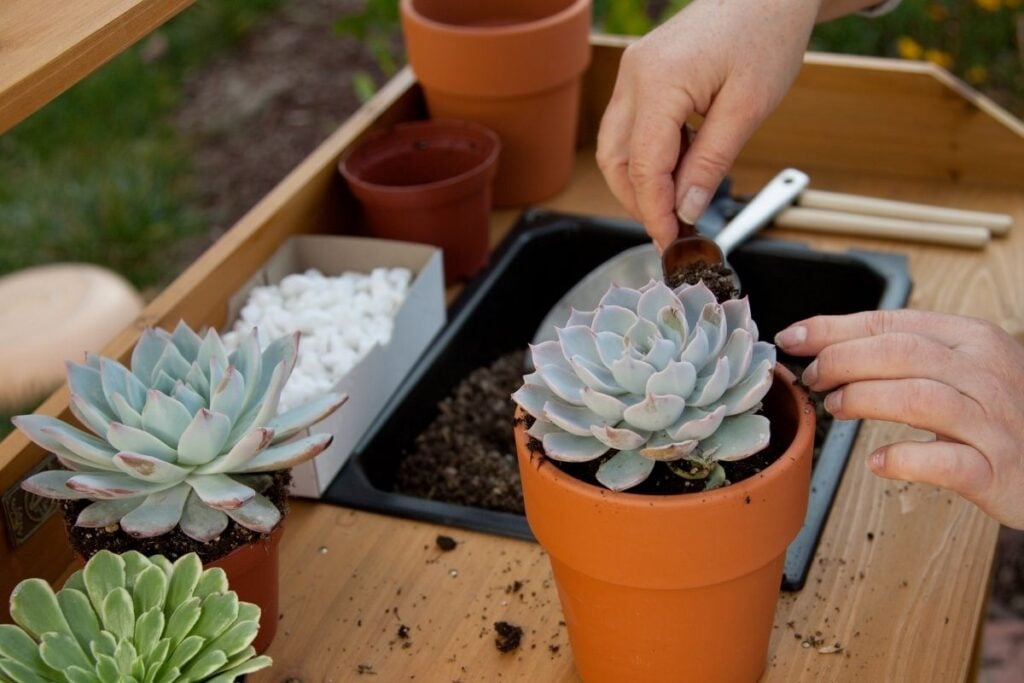
Soil is one of the supreme factors for Hens and Chicks.
You don’t need very fertile soil for them.
Instead, they will do fine in rocky soil. The vital thing is drainage.
Use soil that can drain excess water and, at the same time can, retain some moisture to keep the plant hydrated.
Hens and Chicks don’t require lots of water.
Their broad leaves, stems, and roots are capable of storing water.
So, if you keep them thirsty for some time, they will be fine.
Use sand, gravel, perlite, or pumice in the soil mixes to improve drainage.
Here are some ideal soil mixes for Hens and Chicks:
Recipe 1
- 50% Garden soil/Potting soil
- 50% Sand
- A handful of Compost
Recipe 2
- 25% Potting soil
- 50% Sand
- 15% Perlite/Vermiculite
- 10% Compost/Worm casting
If you don’t want to put so much effort, just use a commercial cactus and succulent soil mix.
It is also best suited for potted Hens and Chicks.
It contains porous materials like perlite or pumice that helps in sound drainage.
The plant will remain alive for 3-4 years.
Within these years, they will continue to grow and multiply profusely.
You can even re-pot them to give them more space to grow and produce chicks.
Now let’s understand the steps to plant Hens and Chicks properly.
Looking for gardening supplies? We have tested 100's of products before recommending them to you guys. Check out our best pick below:
| Image | Gardening Supplies | Best Price? |
|---|---|---|
 Top
Top Top
Top | Raised Garden Bed Kit | Check On Amazon |
 | XLUX Soil Moisture Meter, Plant Water Monitor, Soil Hygrometer Sensor for Gardening, Farming, Indoor and Outdoor Plants, No Batteries Required | No Results |
 Top
Top Top
Top | 82 Pcs Garden Tools Set and Extra Succulent Tools Set | Check On Amazon |
 | Joeys Garden Expandable Garden Hose with 8 Function Hose Nozzle, Lightweight Anti-Kink Flexible Garden Hoses, Extra Strength Fabric with Double Latex Core, (50 FT, Black) | No Results |
 Top
Top Top
Top | Dual Chamber Compost Tumbler | Check On Amazon |
 Top
Top Top
Top | Sunnyglade Plant Stakes | Check On Amazon |
 Top
Top Top
Top | Organic Cold Pressed Neem Seed Oil | Check On Amazon |
 Top
Top Top
Top | Mighty Mint Gallon :-Insect and Pest Control Peppermint Oil | Check On Amazon |
 Top
Top Top
Top | Scotts DiseaseEx Lawn Fungicide | Check On Amazon |
 Top
Top Top
Top | Jacks Classic 20-20-20 All Purpose Fertilizer | Check On Amazon |
 Top
Top Top
Top | 30,000 Seeds Pollinator Attracting Wildflower Mixture | Check On Amazon |
 Top
Top Top
Top | Survival Vegetable Seeds Garden Kit-Over 16,000 Seeds | Check On Amazon |
How to plant Hens and Chicks in pot? (Step-by-step guide)
While growing Hens and Chicks in pots, follow the simple steps below to plant them successfully.
Things required:
- Prepared soil mix
- A pot
- The plant
- Extra pebbles, gravel, or glass beads
Step 1: Selecting the right pot
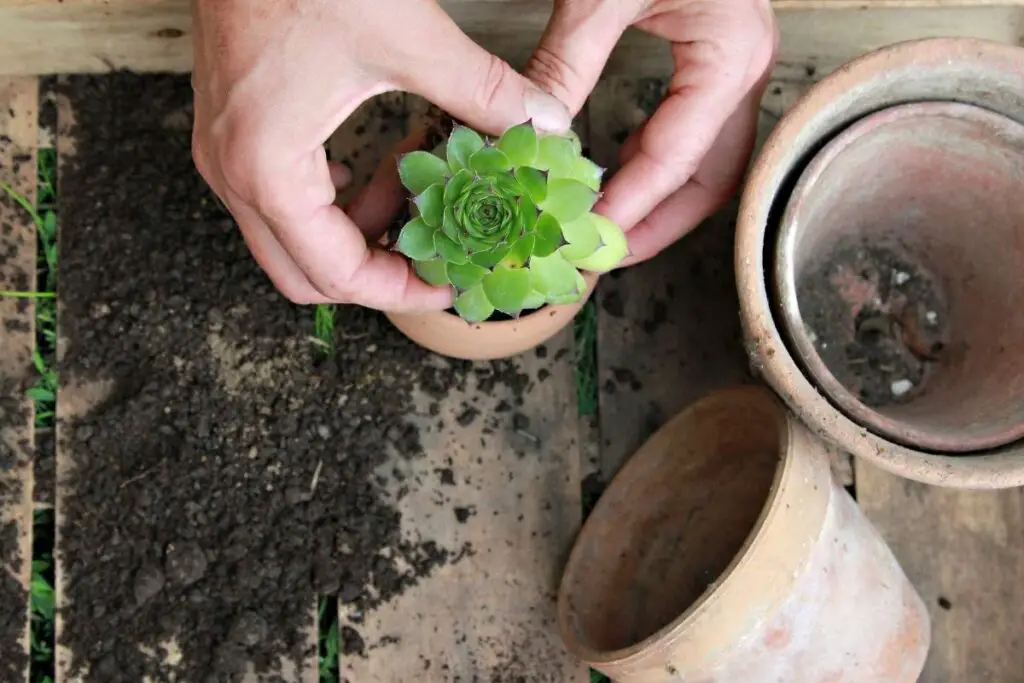
Select a planter of your choice.
You can choose any kind of pot for Hens and Chicks. They look great in all containers.
A shallow one will be good for these succulents as their roots don’t grow much deep.
In a shallow planter, the roots will develop and spread well.
Hens and Chicks will also look great in a strawberry pot.
As Hens and Chicks can multiply profusely every growing season, this pot will get filled up quickly by its babies and look great.
Step 2: Preparing the soil mix
I would suggest you use the recommended soil mix recipes.
They are porous and incite good drainage.
Also, make sure it has drainage holes.
Fill up the chosen pot with 50% of the selected soil mix.
You can also add 25% compost if you are not adding enough porous materials in the potting mix.
Compost will encourage drainage, rapid growth, more offsets, and blooming.
Don’t use peat because they are heavy and highly nutritious.
Your Hens and Chicks will become stretchy.
Step 3: Planting the hens and chicks
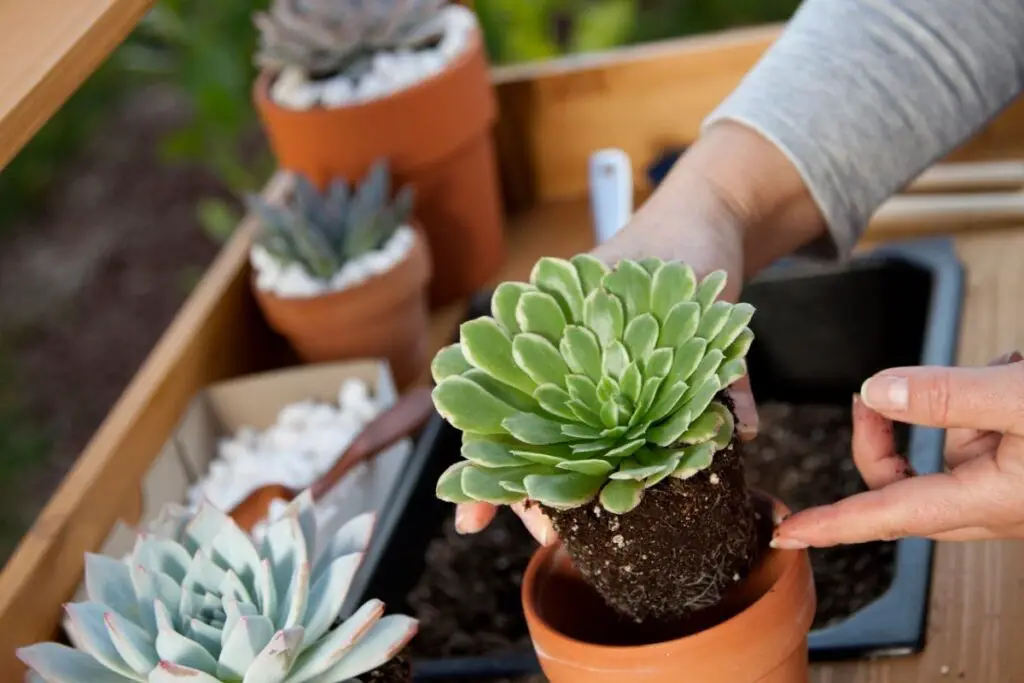
Now, place the Hens and Chicks at the center of the pot in the soil.
The root ball must stay slightly below the mouth level of the planter.
They are ground covers and don’t grow too tall.
Planting them too deep will make them rarely visible.
Now cover the root ball with the rest of the potting mix and press the surrounding soil well to block any air pockets.
Make sure to cover only the roots and not the leaves.
Step 4: Covering the soil
Now add some gravel or glass beads around the plant as topping or mulch.
It will give your container a great look.
Adding these extra toppings will also help in to:
- Reduce evaporation
- Retain heat in the pot
- Improves drainage
Step 5: Watering the plant
Add little water to moist the soil bed. Don’t add too much water.
Only 1-inch of water will be enough to moist the soil.
But do not do this right after planting.
Hens and Chicks already have enough water stored in their leaves, stems, and roots.
Watering them over it can trigger root rot. Start watering after 3 to 4 days.
Start with a small quantity and frequency. Once developed, start usual watering.
Step 6: Moving to a bright sunny spot
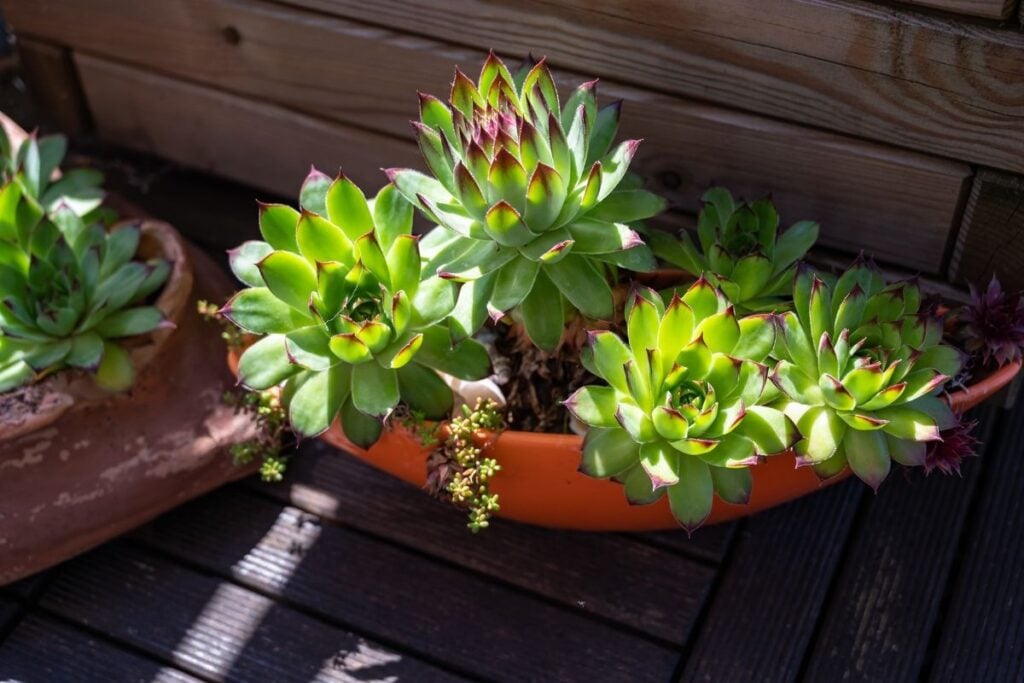
Place them near a sunny spot, be it indoors or outdoors.
If the plant is young, don’t expose them to direct sunlight for 1-2 weeks.
Once they get strong enough, you can give them sunlight as per their need, depending on the variety.
It can be on a deck or patio outside or near a sunny window inside.
Read the “Location” heading to know which direction would be ideal for the plant in your region or home.
How to care for Hens and Chicks in pots?
Hens and Chicks grow best during the spring and summer.
Always plant them in the spring as it is their growing season.
You can avoid summer if your region receives too hot weather.
Don’t plant during the winters. They will not progress their growth because of dormancy.
Now let’s learn to care for them correctly without giving them any distress.
Let them have enough sunlight.
You must have previously read the “Location” point where I have shared about their light requirements.
Read and try to place the Hens and Chicks in the advised directions.
However, you have to keep experimenting to know the best place for your plant.
Make sure that the large varieties can get sunlight throughout the day.
The dwarf varieties, however, will need protection from the afternoon sun.
Too much direct sunlight can cause sunburns.
So, make sure the Hens and Chicks don’t get exposed to the harsh sun.
Also read: How Much Sun Do Hen And Chicks Need? (Light Requirement)
Watering more will save the plant from sunburn.
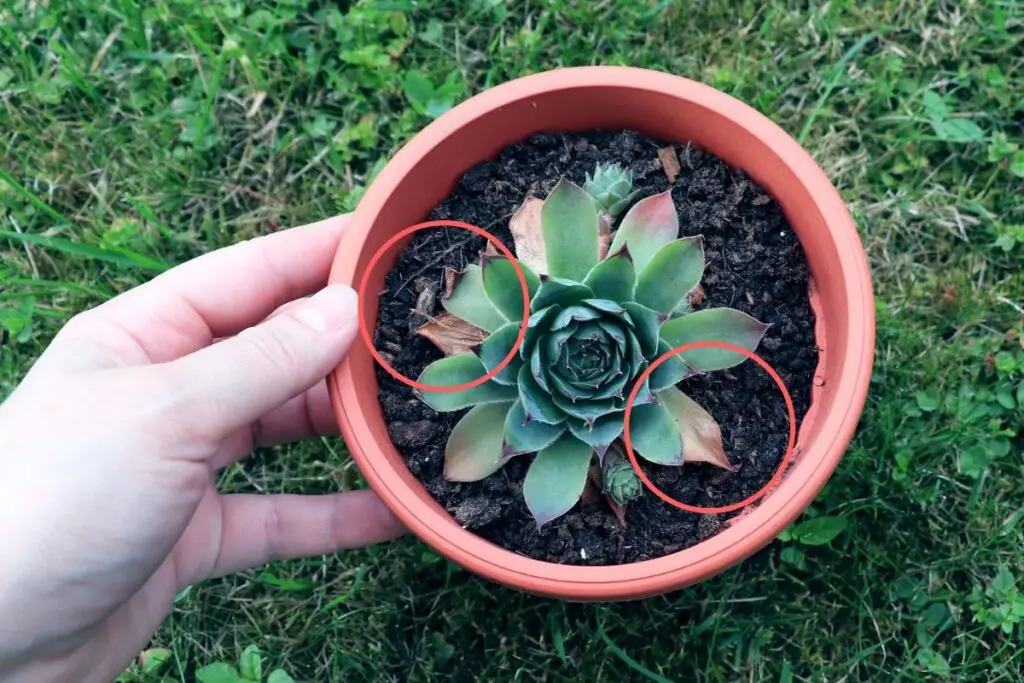
If they receive low light indoors, arrange artificial lights to adjust the lighting.
Maintain a distance of 6-12 inches between the light and plant.
Do not ever deprive them of light. Without proper light, the Hens and Chicks will begin to rot.
Watering Hens and Chicks in pots
Hens and Chicks store water in themselves.
Watering too much can rot them.
Water the Hens and Chicks only when the top 1-2 inches of soil is completely dry, be it indoors or outdoors.
Tracking a perfect routine can be confusing.
Instead of following any schedule, check the moisture before watering.
It will be the best way to understand their watering needs.
However, keeping them a little thirsty for some time will not harm them.
They begin to store water in their leaves, and you can see them turning red or purple, which is not bad.
Use rainwater or distilled water.
Tap water contains many harsh minerals and can make the soil too acidic and affect the plant’s health.
Also read: How Much Water Do Hens And Chicks Need? (Underwatering+Overwatering)
Fertilizing potted Hens and Chicks
Hens and Chicks rarely need any fertilization.
They are known to thrive even in rocky soil.
Too many nutrients can make them stretchy and wild.
They release auxins which help to stimulate their growth.
But, fertilizing a little bit will not harm their health.
Instead, it will encourage faster growth and more baby plants.
Use an all-purpose, mild, balanced fertilizer by making the strength half.
Feed them once during the spring only.
It is the time when they grow actively. So they will take up the fertilizer to grow faster.
Avoid if the Hens and Chicks are outside in summer or winter.
If indoors, fertilize if they are not growing as expected.
Also read: Do Hens And Chicks Need Fertilizer? (+Best Fertilizer For Hens And Chicks)
Keep it in a location where they can get suitable temperature and humidity.
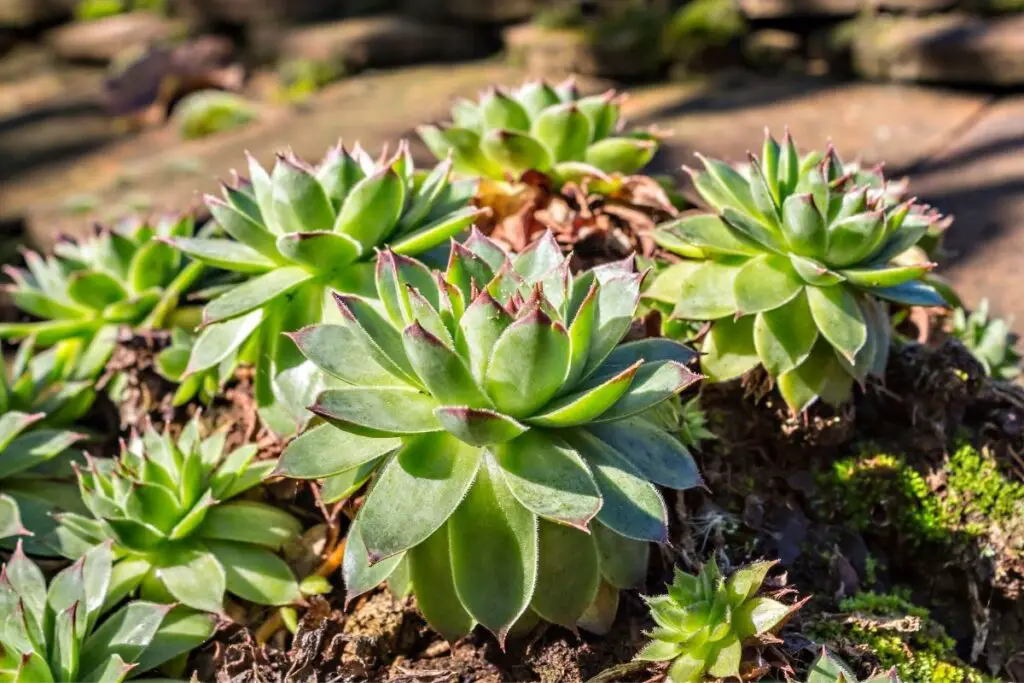
Outdoors, we cannot control temperature and humidity.
You can protect them by bringing them indoors.
Even if the succulents receive extreme temperatures outdoors, it won’t harm them much.
Instead, it reveals their colors, like red, purple, or orange.
The plants produce some pigments to protect the plant from such extreme conditions, due to which they change color.
Indoors, check the temperature of the plant’s location.
Keep the AC on for some minutes or shift it to a cool room if it is too high.
Too high temperatures indoors can increase humidity, thus making them rot.
Avoid areas like near heaters, radiators, kitchen, aquarium, fireplace, and bathroom.
Also read: Where Do Hens And Chicks Grow Best? (Best Spot+What To Look For)
Winter care for potted Hens and Chicks
You can either keep them outside or bring them indoors in the winters.
Outdoors, Hens and Chicks will go dormant. Prepare them for winter.
Reduce the watering frequency and spray some fungicides to prevent fungal diseases.
Keep the pot close to the ground.
It will save the foliage from getting damaged due to frosty winds.
Mulch the plant with stones or pebbles.
Let them have enough sunlight to overwinter them.
Avoid watering in winters if they are outside.
You can even take them indoors if you don’t want them to stay dormant.
Though the plant won’t rest, it will be growing very slowly.
Here, you have to continue watering. Water only when the soil feels dry.
Sometimes, they will be resting even indoors. Resting is good.
It improves and increases their growth rate in their growing months.
Also read: Hens And Chicks Temperature Tolerance: (How Cold, How Hot?)
Final thoughts
Planting Hens and Chicks in containers is as easy as planting in the ground. Make sure that the container has drainage holes.
It is not compulsory to use clay or terra cotta pots. You can also use it according to your choice.
Let them have enough sunlight, be it indoors or outdoors. Hens and Chicks will grow and display colors only if they receive adequate sunlight. Don’t overwater them. Water them when the top 1-2 inches of soil gets bone-dry.
For keeping the potted Hens and Chicks indoors, choose a room having 65-75°F temperature and 30-50% humidity.
Though low temperature would be endurable, temperature and humidity shouldn’t be too high.
Fertilize only during the spring. It promotes fast growth and reproduction.
Reference: Wikipedia, Iowa State University of Science and Technology, The University of Arkansas Division of Agriculture, NSDU, The Ohio State University, Missouri Botanical Garden.
